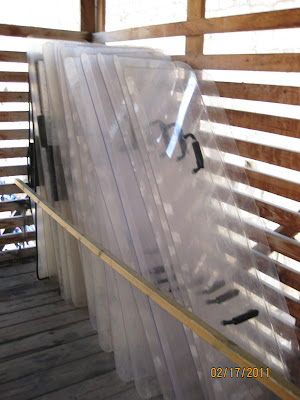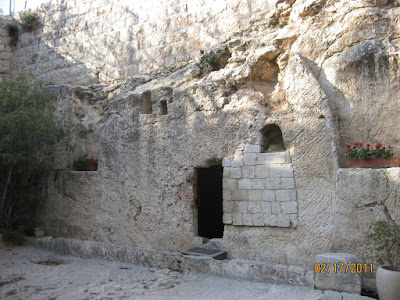Our home away from home! This bus (driven by a great Arab Christian guide named Munir) has taken us all throughout the Holy Land. It's comfortable, reliable, and because of Munir's excellent driving has squeezed through some impossibly small areas.
Today our first stop was to actually go on top of the Temple Mount. The large famous building on top of the Temple Mount is the Dome of the Rock, which has a large gold dome you can see from all over Jerusalem. What's sad is that it's a Muslim shrine, not the Biblical temple which the mount was originally created for. The Dome of the Rock is actually the oldest standing Muslim structure in the world – it has never been destroyed since it was originally built over 1,300 years ago. This picture shows the ramp going up to the Temple Mount; we had to go through a security checkpoint before we were allowed in.
Speaking of security, here are some spare riot shields we saw on the way up the ramp.
Here we are, each sporting Penn State gear, standing next to the Dome of the Rock. Even though we are smiling on the outside, it was eye-opening and disheartening to think how God's holy temple once stood at this very place. But we can take comfort in knowing that Christ came, fulfilled the law, and removed the need for an earthly temple. And we can also take comfort in knowing that He will be returning again soon!
One more picture on the Temple Mount.
Pool of Bethesda
Our next stop was the Pool of Bethesda, the place described in John 5 where disabled people would gather because they felt the water had healing powers. It is the place where Jesus healed a crippled man who couldn't walk on the Sabbath. Street level today (where the railings are) is much higher than it would have been back in the time of Christ, so that's why the pool looks so deep. In reality it was a fairly shallow pool.
Another view of the excavation.
Right next to the Pool of Bethesda was St. Anne's Church. It was built by the Crusaders, and was purposefully constructed to be asymmetrical inside and out. Any guesses why? The early Christians believed that since God was perfect, everything else should be built as imperfect in order to reflect this. I'm not sure I follow the logic 100%, but I can say the acoustics inside were incredible (we sang Amazing Grace as a group).
Snapped this picture on our way to our next destination. How could you not want a Guns N Moses sweatshirt?!
Bell Caves
Shown here is the entrance to the Bell Caves, which doesn't have any specific Biblical connection, but is very neat nonetheless. This used to all be solid rock, but was quarried for its popular building material – Jerusalem Limestone.
They started by excavating a small hole in the top, and then as they went down removed more and more rock at each layer. The result was a bell shape in the rock.
Centuries later you can still see their chisel marks!
Elah Valley
This is the same valley where the armies of the Phillistines threatened the armies of the Israelites with a giant challenger named Goliath! The Elah Valley. David, a man after God's own heart, could not let the name of his living God be defiled and struck down Goliath with a weapon that never should have worked; clearly demonstrating God's power.
A nearby bed of a stream...dried up now, but it could have been the very place where David found his rocks to sling at Goliath!
Shown here is our guide Ronnie giving us a little demonstration using a sling and rock. Let's just say it's good Goliath wasn't around, because his stone had the arc of a pop out to center field.

The Garden Tomb
Our last stop of the day was very exciting... the Garden Tomb. This is believed to be the very site which Jesus Christ was crucified, placed in a tomb, and then resurrected from the dead 3 days later! It was a beautiful site, and has evidence that all seems to point towards it being the actual site of these events – an empty tomb, remains of an expensive garden (a large cistern for water was found), a mountain the looks like a skull, and a location that was outside the original city walls and near a gate.
A second site called the Church of the Holy Sepulchre is claimed by some to be the actual location, but the Garden Tomb seems to have the most evidence and make the most sense. Regardess, the location of the crucifixion and resurrection is not the most important thing, but rather the very fact that these things happened is what we rejoice in! In fact our entire faith rests on these things. As Paul says in 1 Corinthians 15, if Christ has not been raised from the dead then our faith is in vain and is futile, and we are of all people most to be pitied.
The front of the Garden Tomb. Could very well be the very tomb Christ was laid in.
We were allowed to go in – this picture shows the corner believed to be where Christ was.
A very appropriate sign on the way out.
This picture is thought to be the rock described as the "mount of skulls", and is only about 100 yards from the tomb. You can make out a few eye socket looking crevices...the mouth portion is covered up today but pictures taken even 100 years ago show the full skull figure.
Our group had a nice time in the garden area singing a few worship songs, having communion, and a time of teaching. Overall this was a very special and encouraging time.





















No comments:
Post a Comment